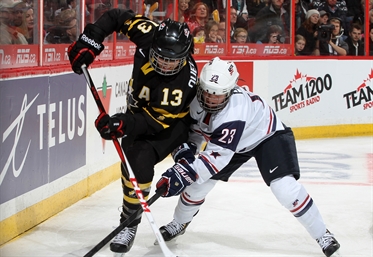Women get ready for battle
Women get ready for battle
Story lines aplenty as 25th anniversary approaches

 Canada and USA will be the usual favourites, but after them the field is wide open. Photo: Andre Ringuette / HHOF-IIHF Images
Canada and USA will be the usual favourites, but after them the field is wide open. Photo: Andre Ringuette / HHOF-IIHF Images
Of course, front and centre will be the Canada-United States rivalry. Every one of the previous 15 tournaments (the tournament wasn’t an annual event until 1997) has featured a gold-medal game between the North Americans, and while the world is closing the gap, it might not be enough to interrupt that expectation for Malmo.
The only change in representation from 2013 is that the Czechs are out and Japan in for 2015. The two nations played a thrilling qualification after Sochi, Japan winning the decisive third game, 2-1, to earn the Malmo invitation.
The Japanese have not played at the top level of the WW since 2009 and in five previous appearances have managed to avoid demotion only once (in 2008). Scoring goals will likely be their biggest challenge.
Canada’s roster will be loaded with experience, but will miss one of the most impactful female players in history in Hayley Wickenheiser, out with a leg injury. One exciting addition to the team might be Sarah Potomak, the 17-year-old who was named tournament MVP of the 2015 WW18 in Buffalo and who is on the training camp roster.
Oddly, Canada will be playing its third major tournament in a row with a new coach. Dan Church was behind the bench in 2013, followed by Kevin Dineen in Sochi. For Malmo, it will be Doug Derraugh. Another coach, another system to learn. How will Canada perform?
The United States will also have a veteran roster led by new head coach and former NHLer Ken Klee. Indeed, the U.S. has won gold at five of the last seven Women’s Worlds and has been as dominant in this event as they have been frustrated at the Olympics, which they haven’t won since 1998.
With a team as deep as the States, Klee has an enviable job picking who he will bring along to Malmo. Stars like Amanda Kessel, Kendall Coyne, Hilary Knight, the Lamoureux sisters…the list goes on.
Barring a huge upset of one of the North American teams, the chase for bronze might be the fiercest ever this year. Switzerland, behind the stellar goaltending of Florence Schelling, comes in as third-place finishers in Sochi (and, previously, in 2012) and a credible contender for another medal in 2015.
Finland, despite having earned ten bronze medals in this tournament, has not won any hardware since 2001. Led by star defenceman Jenni Hiirikoski, the Finns will however miss veteran goalie Noora Raty, who planned to come out of retirement to join the team but had to pull out due to health reasons. Eveliina Suonpaa and Meeri Raisanen will fill in in net.
Russia won bronze in 2013 under general manager Alexei Yashin but finished a disappointing sixth in Sochi. The U18 team was dominant in the bronze game in Buffalo and a good result in Malmo would come as no surprise.
Sweden, meanwhile, has taken a downturn in recent years since its big stars from the “Mirakel” in 2006 have retired. The team hasn’t won a medal since 2007, and given the stiffer competition in recent times a medal on home ice will be no easier than in recent years.
Rounding out the eight-team tournament will be Germany. Like Japan, it lacks the firepower to pose a serious threat to its opponents, but the Germans have managed to stay at the top level since 2011, a goal it hopes to achieve again in Malmo.
The recent format for the tournament remains the same given its success and popularity. Thus, the top four teams will be in Group A (United States, Canada, Russia, Finland) and all automatically advance to the playoff round.
Group B will consist of Germany, Switzerland, Sweden, and Japan. The last two teams will play a relegation series while the top two join the quarter-finals. While an expected gold-medal game between the North Americans should provide thrilling hockey, the fight for bronze will be equally thrilling given the number of teams now capable of competing for third place.
Twenty-five years after the first Women’s Worlds, the 2015 edition promises to be the most competitive ever.
Back to Overview























































